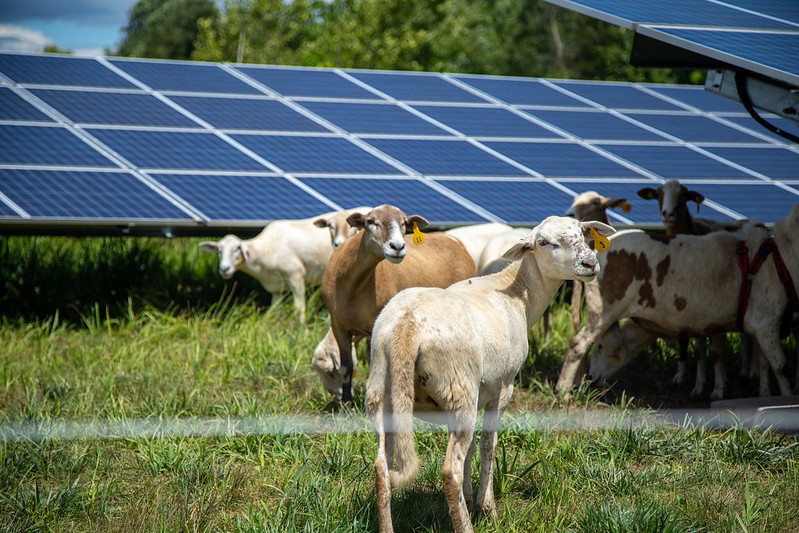Why Solar Panels and Sheep are Perfect Together

A herd of 20 sheep are the latest addition to the solar array at Toyota Motor Manufacturing West Virginia (TMMWV). The five-acre array is the largest in the state and can generate 2.6 megawatts of renewable electricity, which reduces TMMWV’s C02 emissions by an estimated 4 million pounds per year.
And from April to October, the array will provide shelter for sheep.
Sheep are the perfect partner animal for solar panels.
For solar panels to effectively create electricity, vegetation must be kept low. Unchecked growth can lead to unwanted shadows that block the sun’s power-generating rays.
That’s where the sheep come in. On average, it takes about one to five sheep per acre to keep plant growth trimmed. A single sheep can eat up to four pounds of grass per day and can easily fit underneath the solar panels to nibble up weeds that grow in hard-to-reach areas.
Sheep grazing reduces carbon emissions, improves the soil and makes economic sense.
Sheep have a carbon footprint far lower than the typical commercial mower and, unlike large mowers, they don’t spray rock and debris, which could crack or damage the solar panels.
A new study funded by the U.S. Department of Energy’s National Renewable Energy Laboratory found that native vegetation munched on by sheep shows an uptick in carbon capture and improves the soil by increasing the cycling of nutrients, carbon and water. 1
By welcoming the grazers, solar operators save money on land maintenance. After the cost of leasing the land, vegetation management is often their top expense.
Sheep farmers benefit, too. They can add a new revenue stream by leasing land for solar arrays, or, in cases where they need to allow their land to lay fallow to regenerate, they can lease land with solar panels and rotate the flock.
Sheep graze more under solar panels than in open fields.
Researchers from Wageningen University in the Netherlands2 attached data trackers to 80 ewes, placing half in a field that was 60% covered by solar panels and the other half in a traditional open field in late autumn and winter. The sheep in the solar panel field grazed 8% more than their open-field companions and spent 16% less time standing around idle, a warning sign of poor welfare.
In the solar panel fields, the nitrogen content of the grass was 172% higher, meaning it was more nourishing and easily digestible. One likely explanation is that the panels prevented parching and drip-fed the grass with dew.
TMMWV is the company’s first plant to utilize agrivoltaics: using land for both agriculture and solar energy generation.
The use of solar sites for livestock grazing is still in its infancy, but flocks of sheep are already grazing contentedly under and around solar panels in at least 20 states.
According to a Bloomberg NEF outlook, 32 gigawatts of solar capacity are expected to be added in the U.S. in 2023, enough to power 25 million homes. If this trend continues, the U.S. could lose 18.4 million acres of agricultural land by 2040, an area nearly the size of South Carolina.3
That’s a lot of land. And that’s where innovations like agrivoltaics play an important role.
Agrivoltaics allow both solar operators and farmers to use the same land. Utilizing agrivoltaics is also good for the sheep, good for the land and good for the climate. It’s a win for everyone.
For TMMWV, this project is an extension of Toyota’s long-standing commitment to respect the environment and an example of how great things happen when we partner with others.
2 https://research.wur.nl/en/publications/a-preliminary-investigation-of-the-effect-of-solar-panels-and-rot and https://www.weforum.org/videos/putting-solar-panels-on-farms-makes-sheep-happier
3 https://www.bloomberg.com/features/2023-solar-grazing-sheep/



